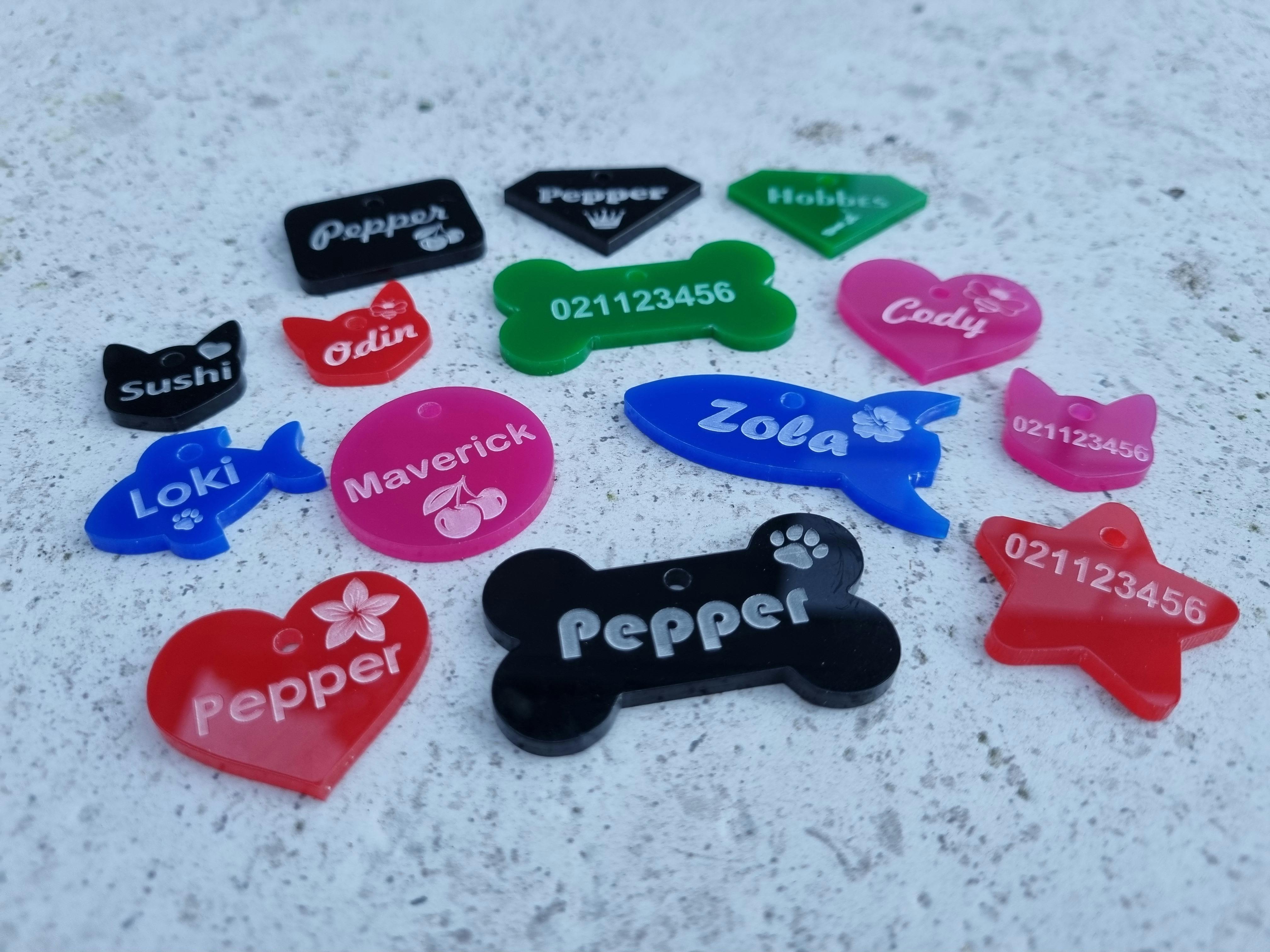Made in New Zealand
1-3 day production time
Global shipping
Methods of pet identification: Ensuring the safety and security of your beloved fur child
Losing a pet is a pet parent's worst nightmare. But this can be avoided with effective pet identification. Learn about different types and the advantages & disadvantages of each.

Losing a pet is a pet parent's worst nightmare. This is why effective pet identification is so important. Accidents happen – gates & doors are left open; fences are jumped; and rabbits are chased. In such instances, having proper identification significantly increases the likelihood of your dog or cat finding their way home. In this blog post, we will explore the advantages and disadvantages of different methods of pet identification.
Microchipping: The critical first line of defence
A microchip is a small grain-sized electronic device that is implanted under the skin. Each microchip contains a unique identification number that is assigned to a specific pet. This number is then linked to the owner's contact information, which is stored in a central database. Microchipping stands apart from other methods of pet identification in that it is safe, permanent and tamper-proof. Microchips cannot be removed or lost; they require no maintenance once implanted; and it’s easy to update contact information on the central database. This makes microchipping the best defence against pet theft or illegal ownership. The only real disadvantages of microchips are that they cannot be read without a specialised microchip scanner, thus limiting immediate accessibility to the pet’s identification.
In New Zealand, the Government requires that all dogs are microchipped (except working farm dogs), but there is no requirement to microchip cats (although we’d strongly encourage it). You can get your dog or cat microchipped at your vet or local animal shelter. Microchip information is stored on the New Zealand Companion Animal Register (NZCAR): https://www.animalregister.co.nz/. This register is also connected to lostpet.co.nz: https://www.lostpet.co.nz/ – a site where you can report a lost or found pet.
Pet identification tags: The traditional solution
Traditional pet identification tags: Traditional pet identification tags are one of the simplest and most widely used methods of identification. These tags typically hang from, or slide onto, the pet's collar and contain vital information such as the pet's name and owner's phone number. Pet tags are made from a wide range of materials including steel, brass, aluminium and plastic. The advantages of traditional tags are that they’re easy to read, cost-effective, widely available and easily customised. The disadvantages are that they can wear out and fall off over time; they can make an annoying jingling noise; and they can also get caught or snagged on objects. Further, since the tags are small, there is a limit to the amount of information they can contain. If you’re looking for a robust and durable traditional tag, Led & Collared offer stainless steel and cast acrylic tag options for both dogs and cats.
QR code pet tags: The use of QR codes on pet identification tags has become increasingly popular. These unique codes can be scanned with a smartphone, providing instant access to the pet owner's contact information. The advantages of scannable QR code pet tags are that they allow quick access to the owner’s contact information (when scanned); they can hold a larger amount of information; and the information can be easily updated. The disadvantages are that these tags can’t be read without a smartphone or QR code scanner and if damaged or scratched in any way, the code will become unreadable.
Personalised pet collars: The innovative and stylish solution
Pet collars with in-built name plates: In-built name plates or tags are an innovative method of pet identification that provide an elegant and secure solution. Typically made from metal, these name plates are integrated into the pet's collar and personalised with the pet's name and owner's contact information. The advantages of in-built name plates are that they can’t fall off; they offer a stylish and elegant identification solution; and they avoid the annoying and potentially dangerous aspects of traditional tags (being the jingling and dangling). The disadvantages of name plates are that they are relatively small, thus limiting the amount of information that can be included; and they cannot be removed and put on another collar (meaning you will need to replace the whole collar if the name plate is damaged). If you’re looking for a collar with a built-in name plate, Led & Collared offer the Scrag Tag Dog Collar.
Personalised pet collars: Another practical and stylish method of pet identification is to have relevant information printed/applied directly onto the collar. This durable and long-lasting solution ensures that the pet's name and contact details remain visible and intact throughout the collar's lifetime. The advantages and disadvantages of personalised pet collars are the same as for in-built name plates. If you’re looking for a personalised collar, Led & Collared offer the Personalised Cat Collar and optional personalisation with a number of our dog collars.
GPS tracking devices: The technological solution
GPS pet tracking devices: In the era of advanced technology, GPS tracking devices have emerged as a modern and high-tech method of pet identification and location. These devices are attached to the pet's collar and allow owners to track their pet's location in real-time using a smartphone or computer. The key advantage of GPS collars is that they allow pet owners to accurately locate their pets in real-time, without having to rely on other people to find the pet and contact the owner. And as an added bonus, these devices can also be used for purposes beyond identification, such as monitoring fitness and activity. The disadvantages of GPS collars are that the pet’s location cannot be determined without a smartphone or computer; they require regular battery charging or replacement; the unit does not provide an easy source of identification for anyone beyond the pet owner; they tend to be expensive; and some GPS devices rely on the mobile phone networks – meaning they are not always effective in remote areas. There are a range of GPS trackers available in New Zealand. The right model will depend on how you plan to use it. If you are a hunter or hiker, you’d want to invest in a self-contained GPS tracking system (such as a Garmin or Dogtra: https://www.dogmaster.co.nz/gps-dog-tracking-collars/ ). But if you’re an urban dweller, something like the Tractive GPS Dog 4 would be more suitable.
Smartphone tracking tags or tiles: The use of smartphone tracking tags or tiles, such as the Apple AirTag or Samsung Tile are often sold as pet collar add-ons. While it may be sorely tempting to use these sleek and discrete tools as pet tracking devices, we’d strongly recommend against it. This is because these devices do not have GPS or cellular capabilities. Rather, they rely on Bluetooth connectivity and proximity to compatible nearby devices to identify a location. This means that their range is highly limited (to about 30-45m); there is a time delay in locating the tag/tile; and location information can be inaccurate. Further, as they are designed for locating personal items, they will not withstand rough treatment or exposure to water. These are not the features you should be looking for in a pet GPS tracker – so please but don’t be fooled into believing these devices will help you find your dog or cat if they go missing, they will not (but they might help you find a lost wallet). At Led & Collared we believe the sale of these devices as pet collar add-ons is misleading and dangerous – for both pet parents and their pets.
Conclusion
Ensuring the safety and security of our pets is a top priority for pet owners. With various methods of pet identification available, we have the means to protect and safeguard our beloved fur children. Whether it's through microchipping, traditional pet identification tags, personalised collars, or innovative technologies like GPS tracking and QR codes, each method offers distinct advantages and disadvantages. At Led & Collared, we recommend use of at least two types of reliable and effective identification – such as microchipping + personalised collars.
- August 2023
© 2023 Led & Collared®. All Rights Reserved. Wellington, New Zealand.





